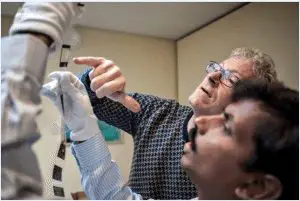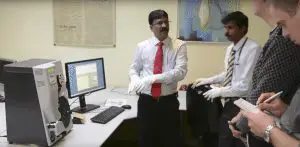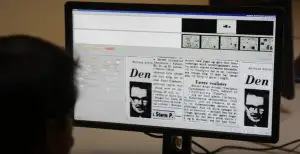Danish Newspapers Travel the Globe Without Leaving Home
From 2012 through 2017 over 32 million microfilmed newspaper images will have been transported from Denmark … to be digitized in Germany … on scanners made in the USA … and processed in India … while never leaving Europe.
Client

Ninestars Information Technologies Pvt. Ltd
Project
Digitization of historic Denmark newspapers from microfilm
Statistics:
32+ million newspaper images from 35mm microfilm
Challenges:
• Collection materials had to be scanned, processed and stored across multiple locations
• Aggressive goal of 50,000 images scanned and processed daily
Equipment/Software:
• Mekel Technology MACH5 high-speed microfilm scanners
• Mekel Technology QuantumScan and QuantumProcess software for automated batch scanning, advanced editing and post-processing
• Ninestars Clips on Cloud (COC)
Project Background
In 2012, The State and University Library of Denmark (Statsbiblioteket) partnered with Aarhus University to form the Aarhus University Library (AUL) with the goal of “development and general education . . . by preserving and making cultural heritage accessible.” As part of this mission, AUL is responsible for preserving and promoting access to The Danish Newspaper Collection, Denmark’s archive of state and local newspapers. The collection dates from 1668 with Denmark’s old- est newspaper, Den Danske Mercurius. The Danish Newspaper Collection, established in 1916, contains original paper material as well as large volumes of microfilm reels. In accordance with a 2014 Danish act on legal deposits (similar to the United States’ National Digital Newspaper Program initiative), AUL embarked on a project to expand the availability of microfilmed newspapers to the Danish public through digitization. AUL selected India-based company Ninestars Information Technologies Pvt. Ltd. (Ninestars), a world-leader in content digitization and media monitoring, to provide the conversion services which use a variety of public and private funds.
Choosing the Right Equipment

Before this project, Ninestars had utilized a competitive microfilm scanner offering 3-in-1 capabilities in their bureau. The modular design afforded a degree off flexibility, but this high-profile project required a superior combination of image quality, fast throughput rates, meticulous accuracy and operator ease-of-use to meet the deadline of 50,000 archival-quality images per day. This conversion rate was deemed necessary to complete the project within the required five-year time frame.
After much comparison shopping and deliberation, Ninestars settled on Crowley’s Mekel Technology MACH-series microfilm scanners. The Mekel Technology MACH5 microfilm scanner offers up to 600 dpi true optical resolution and scan speeds of up to 700 images per minute. Ninestars co-founder, Gokul Krishnan, recalls of their purchasing decision, “The most valuable component of the MACH5 unit to us was the Quantum software, especially the user-friendly, simple workflow and advanced image quality settings such as automatic frame detection.” After a pilot phase during which the standard settings were tested, crosschecked and adjusted, the equipment was installed. Krishnan states, “The implementation phase was very smooth and perfectly consistent; it took a total of six hours from installation and training to full-time use.”
With the MACH5 scanners, the Ninestars teams can process approximately 50,000 images per day, output to 300 dpi grayscale TIFF and JPEG 2000 files.
“It took a total of six hours from installation and training to full-time use.”
~ Gokul Krishnan, Ninestars co-founder
Project Procedures
All told, 33,000 rolls of 35mm microfilm from The Danish Newspaper Collection will have been transported in various-sized batches from AUL in Aarhus, Denmark and delivered to Ninestars’ European scanning bases in Hamburg, Germany and Copenhagen, Denmark. The Ninestars team uses the MACH5 scanners at each location to capture the images using QuantumScan software. The raw images are transferred remotely to agents in Chennai, India for post-processing and quality assurance using Mekel’s QuantumProcess software. After processing, the finalized digital images are transferred to AUL for archiving and hosting online.
Project Challenge

Although there are many challenges in the details of this project, the primary obstacles are: 1) the very high number of images to digitize and process; and 2) the dictate that the original materials (microfilm) not leave Europe. As mentioned above, Ninestars created a stringent vetting and testing process to determine which microfilm scanners could provide the reliability, image quality and speed necessary to complete the project on time and at the quality level required. Although the MACH5 scanners were not the lowest priced, the return on investment over the course of the project when factoring in the reduced number of re-scans necessary using Mekel’s Quantum software suite — and the overall hardiness of the Mekel Scanners which need minimal maintenance — was significant. As Ninestars primary service bureau is based in India, keeping the materials in Europe while performing high-level post-processing (cropping, article segmentation, optical character recognition, etc.) and quality assurance services on thousands of images per day is an enormous challenge. To overcome this, Ninestars uses its flagship digitization platform, Clips on Cloud (COC), to accomplish the services from its service bureau without the transfer of the high-resolution files. The platform– and web-based interfaces enable the capture of the complex instructions and replicate the same on the high-resolution images for final delivery to the client.
Project Goals
As of this printing, over 23 of the 32 million images have been digitized with an expected completion of 2017.
According to the Statsbiblioteket website, “By digitizing these newspapers and making their content available online, the State and University Library is meeting the growing needs of its users for access to the Danish cultural heritage.” After digitization, the newspaper images will be hosted on the Statsbiblioteket’s platform, Mediastream. Users can search for any newspaper in the collection for free; due to copyright considerations, they will only be able to read issues online older than 100 years. More recent issues can be accessed onsite at AUL, The Danish Film Institute or The Royal Library.
ABOUT THE CROWLEY COMPANY
Incorporated in 1980, The Crowley Company is a leading digital and analog imaging technologies company headquartered in Frederick, Md. with manufacturing divisions (Crowley’s Mekel Technology, Wicks and Wilson, Extek Microsystems and HF Processor brands) in California and the U.K. The Crowley Company provides an extensive number of digital document and film conversion services to the publishing, commercial, government and archive sectors and also manufactures, sells and services high-speed microfilm, microfiche and aperture card scanners, book scanners, microfilm duplicators, film processors and micrographics equipment.
Contact us for more information
